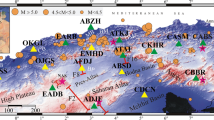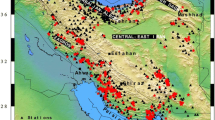Abstract
Ambient seismic field has been used intensively to constrain the Earth’s structure since the early 2000s by extracting impulse response functions (IRFs) between two stations. However, mostly IRF phase information was extracted and used rather than the amplitude. Recently, it was expanded to obtain amplitude information as well as phase, particularly by applying the deconvolution method to the ambient seismic field recorded by broadband seismometers. We investigated the potential of ambient seismic field recorded by accelerometers to extract IRFs, including both phase and amplitude information. We analyzed eight stations widely spaced in South Korea, which also contain co-located accelerometer and broadband velocity seismometer, and demonstrate that the ambient seismic field recorded by accelerometers can be successfully used to extract regional surface waves within the period of 2–10 s. We also investigated the period dependent characteristics of extracted IRFs and found the dominant period band of the secondary microseism recorded in the Korean Peninsula. We expect that the ambient seismic field data recorded by accelerometers can provide much denser IRFs on the Korean Peninsula.
Similar content being viewed by others
References
Bensen, G.D., Ritzwoller, M.H., Barmin, M.P., Levshin, A.L., Lin, F., Moschetti, M.P., and Yang, Y., 2007, Processing seismic ambient noise data to obtain reliable broad-band surface wave dispersion measurements. Geophysical Journal International, 169, 1239–1260.
Bensen, G.D., Ritzwoller, M.H., and Shapiro, N.M., 2008, Broadband ambient noise surface wave tomography across the United States. Journal of Geophysical Research, 113, B05306.
Campillo, M. and Paul, A., 2003, Long-range correlations in the diffuse seismic coda. Science, 299, 547–549.
Choi, J., Kang, T.S., and Baag, C.E., 2009, Three-dimensional surface wave tomography for the upper crustal velocity structure of southern Korea using seismic noise correlations. Geosciences Journal, 13, 423–432.
Cho, K.H., Hermann, R.B., Ammon, C.J., and Lee, K., 2006, Imaging the crust of the Korean peninsula by surface wave tomography. Bulletin of the Seismological Society of America, 97, 198–207.
Denolle, M.A., Dunham, E.M., Prieto, G.A., and Beroza, G.C., 2013, Ground motion prediction of realistic earthquake sources using the ambient seismic field. Journal of Geophysical Research: Solid Earth, 118, 2102–2118.
Farra, V., Stutzmann, E., Gualtieri, L., Schimmel, M., and Ardhuin, F., 2016, Ray-theoretical modeling of secondary microseism P waves. Geophysical Journal International, 206, 1730–1739.
Gualtieri, L., Stutzmann, E., Capdeville, Y., Farra, V., Mangeney, A., and Morelli, A., 2015, On the shaping factors of the secondary microseismic wavefield. Journal of Geophysical Research: Solid Earth, 120, 6241–6262.
Hudson, J.A., Pearce, R.G., and Rogers, R.M., 1989, Source time plot for inversion of the moment tensor. Journal of Geophysical Research, 94, 765–774.
Kang, T.S. and Shin, J.S., 2006, Surface-wave tomography from ambient seismic noise of accelerograph networks in southern Korea. Geophysical Research Letters, 33, L17303.
Kimura, T., Murakami, H., Yano, T.E., Kimura, H., Kazakami, T., and Matsumoto, T., 2014, Background noise characteristics of F-net broadband seismograms. Japan Geoscience Union Meeting 2014, Yokohama, Apr. 28–May. 2, STT57-P03. https://confit.atlas.jp/guide/event-img/jpgu2014/STT57-P03_PG/createpdf/sub
Koper, K.D. and Burlacu, R., 2015, The fine structure of double-frequency microseisms recorded by seismometers in North America. Journal of Geophysical Research: Solid Earth, 120, 1677–1691.
Kwak, S., Song, S.G., Kim, G., Cho, C.S., and Shin, J.S., 2017, Investigating the capability to extract impulse response functions from ambient seismic noise using a mine collapse event. Geophysical Research Letters, 44, 9653–9662.
Landès, M., Hubans, F., Shapiro, N.M., Paul, A., and Campillo, M., 2010, Origin of deep ocean microseisms by using teleseismic body waves. Journal of Geophysical Research, 115, B0530.
Lee, S.J., Rhie, J., Kim, S., Kang, T.S., and Kim, G.B., 2015, Ambient seismic noise tomography of the southern East Sea (Japan Sea) and the Korea Strait. Geosciences Journal, 19, 709–720.
Lin, F.C., Ritzwoller, M.H., Townend, J., Savage, M., and Bannister, S., 2007, Ambient noise Rayleigh wave tomography of New Zealand. Geophysical Journal International, 170, 649–666.
McNamara, D.E. and Buland, P.R., 2004, Ambient noise levels in the continental United States. Bulletin of Seismological Society of America, 94, 1517–1527.
Miyake, H., Beroza, G.C., and Denolle, M., 2009, Ambient noise Green’s function simulation of long-period ground motion for reverse faulting. AGU Fall Meeting 2009 (Abstract), San Francisco, Dec. 14–18, S43A-1958. https://abstractsearch.agu.org/meetings/2009/FM/S43A-1958.html
Nishida, K., 2013, Earth’s background free oscillations. Annual Review of Earth and Planetary Sciences, 41, 719–740.
Nishida, K., Kawakatsu, H., and Obara, K., 2008, Three-dimensional crustal S wave velocity structure in Japan using microseismic data recorded by Hi-net tiltmeters. Journal of Geophysical Research, 113, B10302.
Prieto, G.A. and Beroza, G.C., 2008, Earthquake ground motion prediction using the ambient seismic field. Geophysical Research Letters, 35, L14304.
Roux, P., Sabra, K.G., Kuperman, W.A., and Roux, A., 2005, Ambient noise cross correlation in free space: Theoretical approach. The Journal of the Acoustical Society of America, 117, 79–84.
Shapiro, N.M. and Campillo, M., 2004, Emergence of broadband Rayleigh waves from correlations of the ambient seismic noise. Geophysical Research Letters, 31, L07614.
Shapiro, N.M., Campillo, M., Stehly, L., and Ritzwoller, M.H., 2005, High-resolution surface-wave tomography from ambient seismic noise. Science, 307, 1615–1618.
Sheen, D.-H. and Shin, J.S., 2016, Observation of continuous microseismic P waves in Asia. Journal of Geophysical Research: Solid Earth, 121, 248–259.
Stehly, L., Campillo, M., and Shapiro, N.M., 2006, A study of the seismic noise from its long-range correlation properties. Journal of Geophysical Research, 111, B10306.
Takagi, R., Nishida, K., Maeda, T., and Obara, K., 2018, Ambient seismic noise wavefield in Japan characterized by polarization analysis of Hi-net records. Geophysical Journal International, 215, 1682–1699.
Yang, Y. and Ritzwoller, M.H., 2008, Characteristics of ambient seismic noise as a source for surface wave tomography. Geochemistry, Geophysics, Geosystems, 9, Q02008.
Yang, Y., Ritzwoller, M.H., Levshin, A.L., and Shapiro, N.M., 2007, Ambient Rayleigh wave tomography across Europe. Geophysical Journal International, 168, 259–274.
Acknowledgments
We would like to thank two anonymous reviewers and the editor for their thoughtful review comments, which helped to improve our manuscript significantly. We are also indebted to Hiroe Miyake for useful discussion regarding this study. We would like to thank both KIGAM and KMA for providing continuous seismic data. This study was supported by a See-At Project funded by the Korea Meteorological Administration (KMA) (NP2017-047) and by a Basic Research Project of the Korea Institute of Geoscience and Mineral Resources (KIGAM) funded by the Ministry of Science and ICT (MSIT, Korea) (GP2020-027).
Author information
Authors and Affiliations
Corresponding author
Additional information
Publisher’s Note Springer Nature remains neutral with regard to jurisdictional claims in published maps and institutional affiliations.
Rights and permissions
About this article
Cite this article
Park, E., Kwak, S., Song, S.G. et al. Ambient seismic field recorded by accelerometers for extracting impulse response functions in the Korean Peninsula. Geosci J 25, 197–209 (2021). https://doi.org/10.1007/s12303-020-0014-y
Received:
Accepted:
Published:
Issue Date:
DOI: https://doi.org/10.1007/s12303-020-0014-y




